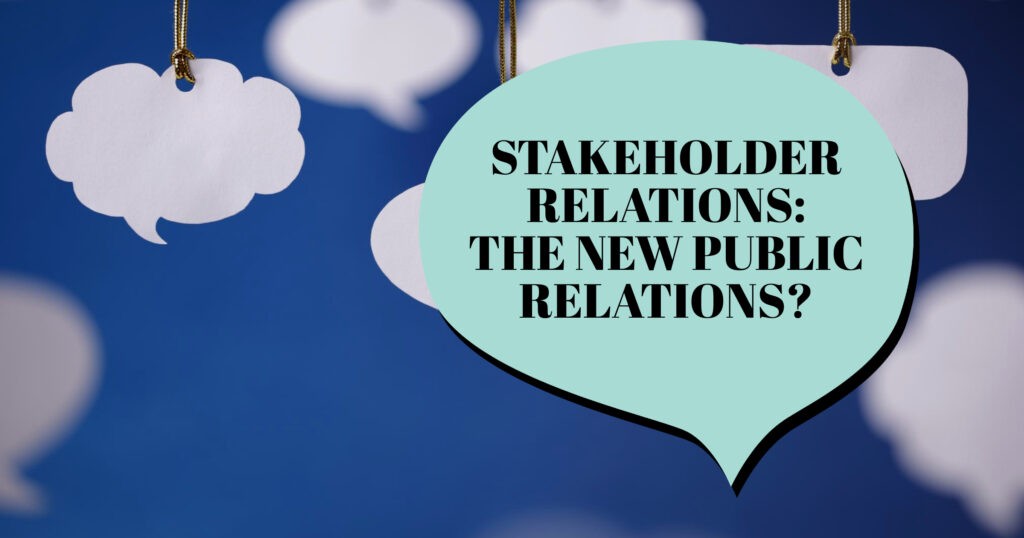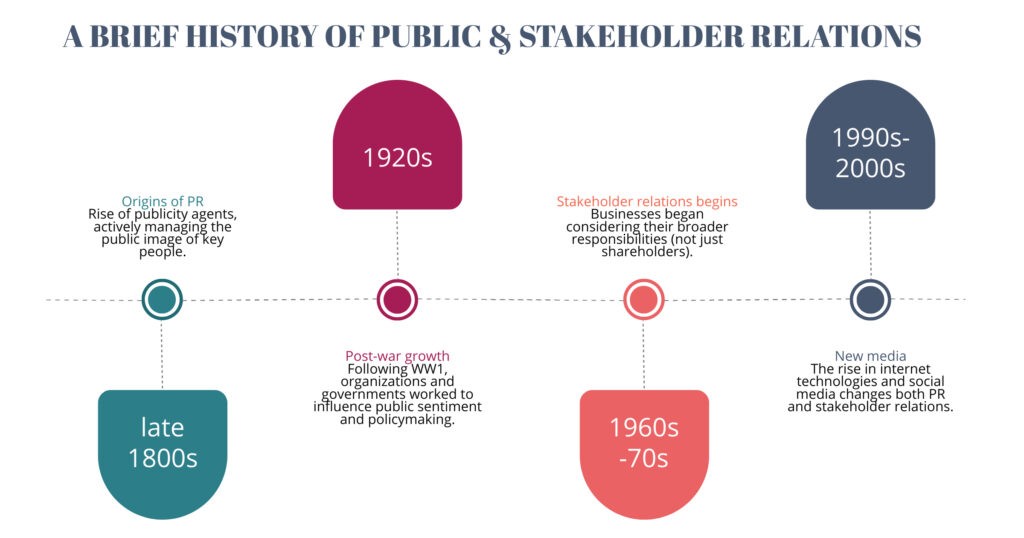Stakeholder Relations: The New Public Relations?

It’s undeniable that there’s a lot of crossover between stakeholder relations and public relations. Professionals working in either field share many of the same goals and processes. But what are the differences? And if you had to pick, which practice should you focus on?
Let’s take a look at the facts, the history, and the relevance of both stakeholder and public relations today.
Stakeholder Relations vs Public Relations: Similarities and Differences
Stakeholder relations involves managing the interests, expectations, needs, and responsibilities between the organization and its stakeholders. This often includes stakeholder identification and analysis, stakeholder planning, relationship building, collaboration, communication, conflict resolution, governance, public participation, and reporting.
Learn more about stakeholder management, stakeholder engagement, the importance of stakeholders, stakeholder plans, and stakeholder analysis.
Public relations involves strategically communicating in order to build beneficial relationships between an organization and its public. This often includes reputation management, strategic communications, media relations, crisis handling, and communication management.
The above definitions might sound quite similar, but in reality, there are some key similarities and differences between the two:
Similarities |
Differences |
|
|
A Brief History Lesson

“If you want to understand today you have to search yesterday.”
– Pearl S. Buck, American novelist
To properly answer the question of whether stakeholder relations is the new public relations, we have to go back a bit to where each practice began, and see how they have evolved over the years.
Modern public relations originated in the late 1800s, when people known as publicity agents would use the news media to promote sports stars, politicians, and circus stars — in an attempt to shape their public image. Similarly, organizations began more actively managing their relationships with customers, employees, or communities. The practice of PR really took off following World War 1, with organizations and governments keen to influence public sentiment and policymaking.
Throughout the next few decades, PR became more widespread via trade associations and university programs — and the growth in mass media increased the potential impact of public relations activities. The practice further evolved at the turn of the century, with the rise of new media technologies, especially social media. And today, public relations remains a powerful force in media and oganizations around the world.
Stakeholder relations is a much newer concept than PR, though there’s some disagreement on exactly when it started. In the 1960s and 70s, businesses began thinking about how they might be responsible for more stakeholder groups beyond just their shareholders. People began to talk about internal and external groups, such as customers, suppliers, employees, and communities — and how a business might also meet their interests and expectations.
Organizational approaches to stakeholder relations evolved in the 1990s and 2000s, with more focus placed on environmental and ethical issues, and an increasingly global outlook. Companies were increasingly expected to take responsibility for their impact on stakeholders, including partners, regulators, and workers.
The rise in new media (especially social media) also impacted stakeholder relations, with a broader range of stakeholders having access to information and the ability to voice their opinions and be heard, and the public demanded greater transparency and accountability. At the same time, organizations realized the strategic benefits of open engagement and participation from stakeholders — and began to go beyond simply informing or managing their stakeholders.
Stakeholder theory is continuing to evolve and increase in popularity among a broader range of organizations, but the practice of stakeholder management and engagement is now well established.
Is Stakeholder Relations the New Public Relations?

Although stakeholder relations emerged much later than public relations, and has potentially borrowed a few ideas from PR, the two approaches remain separate and worthwhile disciplines on their own.
Public relations remains focused on the public’s broader perceptions of the company, and a lot of their impact and reach comes via relationships and communication with the media.
But stakeholder relations involves managing or engaging with a range of stakeholder groups that have an interest in, an influence on, or are impacted by the organization or project. It’s broader than public relations, and its goals are typically focused on facilitating a successful project via more complete knowledge, better communication, participation/engagement, and solutions that meet the needs of more stakeholders.
That said, both of these functions can work well together because there’s plenty of overlap between stakeholder relations and public relations.
Stakeholder Relations & Public Relations: Towards a Collaborative Approach
So, what does this mean for your organization?
If you already have access to both PR and stakeholder relations professionals (whether in-house or contractors), it’s time to encourage greater collaboration and sharing between these teams.
Both groups should coordinate communications/messaging, share contacts, collaborate on campaigns, and share ideas. Stakeholder professionals will likely have valuable insights that could help shape an organization’s PR strategy — and public relations professionals could support the stakeholder team with timely and relevant media releases (that could help build brand visibility and rapport with key stakeholders).
A practical starting place would be to introduce regular meetings where both groups can share their goals, plans, and activities — and from there, begin to coordinate their work. Public relations professionals and stakeholder professionals alike will benefit from this, working more effectively and efficiently together.
Or perhaps you currently lack a stakeholder relations team or approach. If you have been relying on public relations to carry out some stakeholder functions, it’s time to address this gap. Learn more about the basics of stakeholder engagement and stakeholder management — and start to plan how you might incorporate these skills and processes into your projects through hiring or upskilling.
By the way, if you’re looking for powerful, user-friendly software to help support your stakeholder relations team or improve your stakeholder practices, check out Simply Stakeholders.






























